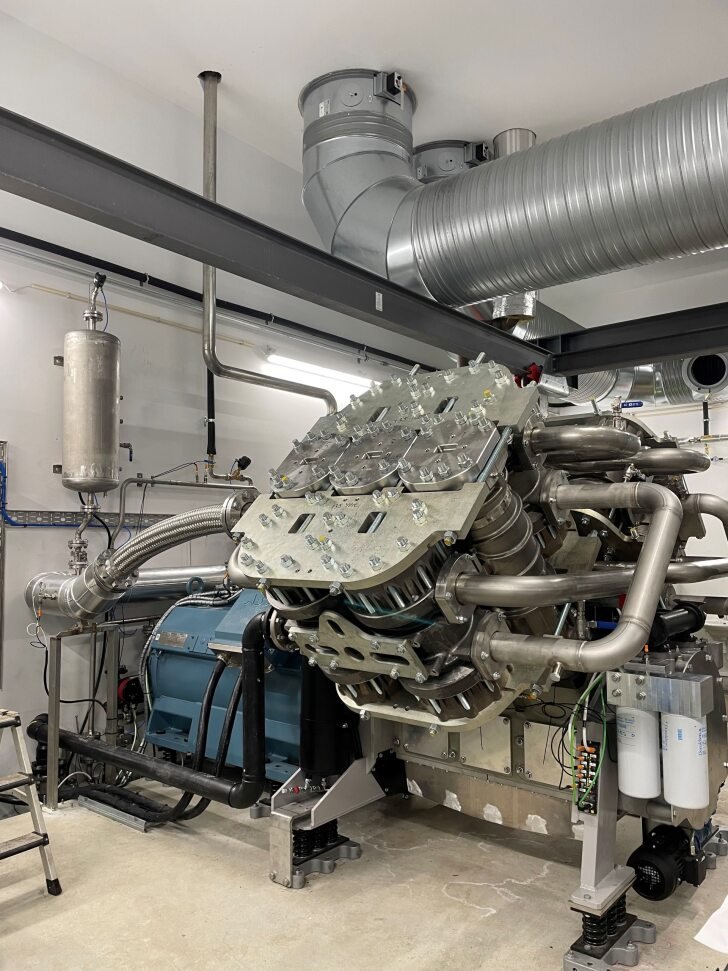HoegTemp produces steam at Pelagia fish plant
Enerin’s HoegTemp high-temperature heat pump installed at Pelagia, Måløy where it will be used to produce steam.
The commissioning of the 400-kilowatt HoegTemp heat pump at the Pelagia Måløy fish processing plant in Norway is progressing as planned.
We would like to report that the initial testing and start-up of our industrial heat pump at Pelagia has been successful. The HoegTemp high-temperature heat pump (HTHP) has started initial steam delivery, and we are moving towards full load.
“We have spun the heat pump, produced steam for the first time, and now we are waiting to go at full speed.”
The Enerin 400kW first stage heat pump will deliver steam at 5 bar pressure in the fishmeal and fish oil processes. The heat pump will utilise waste heat using various heat sources in the range of 15-90°C and deliver temperatures of 200–250°C (referred to as the sink temperature).
For steam applications, HoegTemp heats a steam generator that boils water to produce steam, essentially replacing traditional boilers with sustainable thermal energy with less greenhouse gas emissions. Preferably using renewable-generated electricity, the heat pump can recycle heat from a cooling circuit, a waste heat stream, or directly from the ambient air, using fan coils – thereby generating more thermal heat energy efficiency gains than the energy it consumes.
“For ENERIN the project is a showcase for the heat pump’s unique flexibility by demonstrating its robustness towards fluctuating conditions. Due to this, the number of processing hours for the factory can be extended because the HoegTemp is able to deliver and collect energy at different temperature levels.”
Higher temperatures are required at Pelagia to turn the skin and bones from the fish into a “watery soup” where the water is evaporated off to a point where it can be dried and turned into a fine, dry powder for animal feed.
To optimise the operation of the HoegTemp HTHP, especially during the batch process at the plant when the boats come in with the catch, the heat pump can utilise seawater temporarily as a heat source.
“With seawater access, the Stirling heat pump can be in operation for an additional 5-6 hours before the waste heat becomes available for recycling.
In principle, this adjustment could extend the heat pump’s operational hours by approximately 400–500 hours per year, although we are investigating other ways in which wastewater at ambient temperature could be recycled.”
Currently, the Pelagia manufacturing plants use fossil-fired steam boilers that produce steam (175° Celsius), and to heat air in the dryers for the final stages of product drying (200–250°C).
Pelagia aims to achieve a lower energy input for each unit of produced product because the energy efficiency, or Co-efficient of Performance, of the heat pumps is significantly higher than for fossil-fired steam boilers. The company wants to decrease its greenhouse gas emissions at the factory and reduce the amount of carbon dioxide quotas it needs to buy to offset current emissions.
Read about Enerin’s HoegTemp installation at Pelagia in the Forbes story by WeDon’tHaveTime journalist – Nick Nuttall.
The Pelagia installation is part of the European-funded SUSHEAT project. The Pelagia Måløy site where the Enerin heat pump is installed, below (Photo: Pelagia).
Optimally utilising raw materials is part of Pelagia’s sustainability goals where 100 per cent of the fish is used. Pelagia Food processes solely wild-caught fish.




